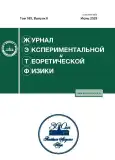Caustic-like Structures in UHECR Flux after Propagation in Turbulent Intergalactic Magnetic Fields
- Autores: Dolgikh K.1,2, Korochkin A.2,3, Rubtsov G.1,2, Semikoz D.4, Tkachev I.1,2
-
Afiliações:
- Institute for Nuclear Research of the Russian Academy of Sciences
- Novosibirsk State University
- Universit� Libre de Bruxelles
- APC, Universit� Paris Cit�
- Edição: Volume 163, Nº 6 (2023)
- Páginas: 792-795
- Seção: Articles
- URL: https://journals.rcsi.science/0044-4510/article/view/145416
- DOI: https://doi.org/10.31857/S0044451023060044
- EDN: https://elibrary.ru/DEDUQZ
- ID: 145416
Citar
Texto integral
Resumo
UHECR propagation in a turbulent intergalactic magnetic field in the small-angle scattering regime is well understood for propagation distances much larger than the field coherence scale. The diffusion theory doesn’t work and unexpected effects may appear for propagation over smaller distances, from a few and up to 10–20 coherence scales. We study the propagation of UHECRs in this regime, which may be relevant for intermediate mass UHECR nuclei and nG scale intergalactic magnetic fields with 1 Mpc coherence scale. We found that the trajectories form a non-trivial caustic-like pattern with strong deviation from isotropy. Thus, measurements of the flux from a source at a given distance will depend on the position of the observer.
Sobre autores
K. Dolgikh
Institute for Nuclear Research of the Russian Academy of Sciences;Novosibirsk State University
Email: jetp@kapitza.ras.ru
117312, Moscow, Russia; 630090, Novosibirsk, Russia
A. Korochkin
Novosibirsk State University;Universit� Libre de Bruxelles
Email: jetp@kapitza.ras.ru
630090, Novosibirsk, Russia; CP225 Boulevard du Triomphe, 1050, Brussels, Belgium
G. Rubtsov
Institute for Nuclear Research of the Russian Academy of Sciences;Novosibirsk State University
Email: jetp@kapitza.ras.ru
117312, Moscow, Russia
D. Semikoz
APC, Universit� Paris Cit�
Email: jetp@kapitza.ras.ru
Observatoire de Paris 119, 75205, Paris, France
I. Tkachev
Institute for Nuclear Research of the Russian Academy of Sciences;Novosibirsk State University
Autor responsável pela correspondência
Email: jetp@kapitza.ras.ru
117312, Moscow, Russia; 630090, Novosibirsk, Russia
Bibliografia
- F. Casse, M. Lemoine, and G. Pelletier, Phys. Rev. D 65, 023002 (2016).
- G. Giacinti, M. Kachelriess, and D. V. Semikoz, Phys. Rev. Lett. 108, 261101 (2012).
- G. Giacinti, M. Kachelriess, and D. V. Semikoz, JCAP 07, 051 (2018).
- D. Harari, S. Mollerach, and E. Roulet, Phys. Rev. D 93, 063002 (2016).
- D. Harari, S. Mollerach, and E. Roulet, JHEP 10, 047 (2000).
- D. Harari, S. Mollerach, and E. Roulet, and F. Sanchez, JHEP 03, 045 (2002).
- K. Dolag, M. Kachelriess, and D. V. Semikoz, JCAP 01, 033 (2009).
- D. Harari, S. Mollerach, and E. Roulet, JHEP 08, 022 (1999).
- V. Berezinsky and O. Kalashev, Phys. Rev. D 94, 023007 (2016).
- R. Alves Batista, A. Dundovic, M. Erdmann, Karl-Heinz Kampert, D. Kuempel, G. M�ller, G. Sigl, A. van Vliet, D. Walz, and T. Winchen, JCAP 05, 038 (2016).
- R. Alves Batista et al., JCAP 09, 035 (2022).
- A. Zonca, L. Singer, D. Lenz, M. Reinecke, C. Rosset, E. Hivon, and K. Gorski, Journal of Open Source Software 4, 1298 (2019).
- K. M. G�rski, E. Hivon, A. J. Banday, B. D. Wandelt, F. K. Hansen, M. Reinecke, and M. Bartelmann, Astrophys. J. 622, 759 (2005).
- J. Giacalone and J. R. Jokipii, Astrophys. J. 520, 204 (1999).
Arquivos suplementares









